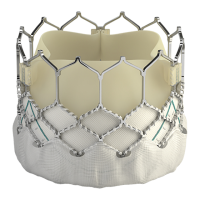32
Table 17: Patient Demographics and Baseline Characteristics of the EP Population
Demographics &
Characteristics
SAPIEN 3 Valve
PIIA-SAVR
(N=938)
Overall
(N = 1074)
TF Only
(N = 948)
Non-TF Only
(N=126)
Porcelain aorta 1/1074
(0.1%)
1/948
(0.1%)
0/126 (0.0%)
Chest deformities that
preclude an open chest
1/1074
(0.1%)
1/948
(0.1%)
0/126 (0.0%)
0/938
(0.0%)
Cirrhosis 4/1074
(0.4%)
4/948
(0.4%)
0/126 (0.0%)
(0.4%)
Echocardiographic findings (Valve Implant Population)
Effective orifice area
2
0.7 ± 0.17 0.7 ± 0.16 0.7 ± 0.18
0.7±0.20
Mean aortic-valve gradient
- mmHg
46.1 ±
12.63
46.1 ±
12.66
45.8 ± 12.47
44.7±12.55
Mean left ventricular
ejection fraction (LVEF) %
58.5 ±
13.36
58.8 ±
13.24
56.0 ± 14.05
55.4±11.75
Moderate or severe mitral
regurgitation
91/1033
(8.8%)
87/909
(9.6%)
4/124 (3.2%)
(18.2%)
Continuous measures - Mean ± SD; Categorical measures – n/total no. (%)
Safety and Effectiveness Results
Primary Endpoints
The primary endpoint was a composite of all-cause death, stroke, and AI ≥ moderate at 1 year. The
weighted proportion difference of the primary endpoint was -9.2% (90% CI: [-12.4%, -6.0%]) using the
average treatment effect on the treated (ATT) method
[2]
, as shown in Table 18 and Figure 19. Since the
upper limit of the CI was < 7.5%, non–inferiority was met.
Table 18:
Primary Endpoint Non-Inferiority Test
(VI Population)
Propensity
Score Quintile
Pooled
Proportion
Difference(ATT
Method*)
†
Margin
for Non-
Inferiority
Test
SAPIEN 3
(N=1069)
PIIA-SAVR
(N=936)
Composite of all-cause
death, all stroke, and aortic
insufficiency (AI) ≥ moderate
at 1 year
13.0% 23.2%
-9.2%
[-12.4%, -6.0%]
7.5% Pass
* ATT: average treatment effect on the treated
†
Two-sided 90% Wald-type confidence interval
Figure 19: Forest Plot – Composite of All Death, All Stroke and AI ≥ Moderate (VI Population)

